A Detailed Numerical Study on Aerodynamic Interactions of Tandem Wheels on a Generic Vehicle
Abstract
:1. Introduction
2. Methodology
2.1. Problem Definition
2.2. Numerical Model
2.3. Case Set-Up
3. Results
3.1. Grid Verification
3.2. Validation
3.3. Effect of Rear Wheels
3.4. Rear Wheel and Wheelhouse Vortices
3.5. Effects of Wheel Proximity on Wheel Flow Structures
4. Conclusions
Author Contributions
Funding
Data Availability Statement
Acknowledgments
Conflicts of Interest
References
- Schuetz, T.C. Aerodynamics of Road Vehicles, 5th ed.; SAE International: Warrendale, PA, USA, 2015. [Google Scholar] [CrossRef]
- Demarco, K.; Stratton, J.; Chinavare, K.; VanHouten, G. The Effects of Mass and Wheel Aerodynamics on Vehicle Fuel Economy; SAE Technical Papers; SAE International: Warrendale, PA, USA, 2017. [Google Scholar] [CrossRef]
- Palin, R.; Johnston, V.; Johnson, S.; D’Hooge, A.; Duncan, B.; Gargoloff, J.I. The Aerodynamic Development of the Tesla Model S—Part 1: Overview; SAE Technical Papers; Series 1; SAE International: Warrendale, PA, USA, 2012. [Google Scholar] [CrossRef]
- Elofsson, P.; Bannister, M. Drag Reduction Mechanisms Due to Moving Ground and Wheel Rotation in Passenger Cars; SAE Technical Papers; SAE International: Warrendale, PA, USA, 2002. [Google Scholar] [CrossRef]
- Mercker, E.; Breuer, N.; Berneburg, H.; Emmelmann, H.J. On the Aerodynamic Interference Due to the Rolling Wheels of Passenger Cars; SAE Technical Papers; SAE International: Warrendale, PA, USA, 1991. [Google Scholar] [CrossRef]
- Wickern, G.; Zwicker, K.; Pfadenhauer, M. Rotating Wheels—Their Impact on Wind Tunnel Test Techniques and on Vehicle Drag Results; SAE Technical Papers; SAE International: Warrendale, PA, USA, 1997; Volume 106, pp. 254–270. [Google Scholar]
- Krajnović, S.; Sarmast, S.; Basara, B. Numerical Investigation of the Flow Around a Simplified Wheel in a Wheelhouse. J. Fluids Eng. 2011, 133, 111001. [Google Scholar] [CrossRef]
- Wiedemann, J. The Influence of Ground Simulation and Wheel Rotation on Aerodynamic Drag Optimization-Potential for Reducing Fuel Consumption; SAE Technical Papers; SAE International: Warrendale, PA, USA, 1996. [Google Scholar] [CrossRef]
- Fackrell, J.E. The Aerodynamics of an Isolated Wheel Rotating in Contact with the Ground; University of London: London, UK, 1974. [Google Scholar]
- Cogotti, A. Aerodynamic Characteristics of Car Wheels. In Technological Advances in Vehicle Design; Special Publication SP; Inderscience Enterprises Limited: Geneva, Switzerland, 1983. [Google Scholar]
- Axon, L.; Garry, K.; Howell, J. An Evaluation of CFD for Modelling the Flow Around Stationary and Rotating Isolated Wheels; SAE Technical Papers; Series 1; SAE International: Warrendale, PA, USA, 1998. [Google Scholar] [CrossRef]
- Axon, L.; Garry, K.; Howell, J. The Influence of Ground Condition on the Flow Around a Wheel Located within a Wheelhouse Cavity; SAE Technical Papers; Series 1; SAE International: Warrendale, PA, USA, 1999. [Google Scholar] [CrossRef]
- Diasinos, S.; Barber, T.J.; Doig, G. The effects of simplifications on isolated wheel aerodynamics. J. Wind Eng. Ind. Aerodyn. 2015, 146, 90–101. [Google Scholar] [CrossRef]
- Régert, T.; Lajos, T. Description of flow field in the wheelhouses of cars. Int. J. Heat Fluid Flow 2007, 28, 616–629. [Google Scholar] [CrossRef]
- Regert, T.; Schwarczkopf, A.; Lajos, T. The Effect of Wheels on the Aerodynamic Characteristics of an Ahmed Body. In Proceedings of the 3rd European Automotive CFD Conference, Frankfurt, Germany, 5–6 July 2007; pp. 1–11. [Google Scholar]
- Dimitriou, I.; Klussmann, S. Aerodynamic Forces of Exposed and Enclosed Rotating Wheels as an Example of the Synergy in the Development of Racing and Passenger Cars; SAE Technical Papers; Series 1; SAE International: Warrendale, PA, USA, 2010. [Google Scholar] [CrossRef]
- Skea, A.F.; Bullen, P.R.; Qiao, J. CFD Simulations and Experimental Measurements of the Flow over a Rotating Wheel in a Wheel Arch; SAE Technical Papers; Series 1; SAE International: Warrendale, PA, USA, 2000. [Google Scholar] [CrossRef]
- Fabijanic, J. An Experimental Investigation of Wheel-Well Flows; SAE Technical Papers; SAE International: Warrendale, PA, USA, 1996; pp. 161–172. [Google Scholar]
- Régert, T.; Lajos, T. Investigation of Flow Field Past Rotating Wheels of Cars. Model Fluid Flow, Budapest. Available online: https://www.ara.bme.hu/~regert/publications/regert_lajos_cmff2003.pdf (accessed on 10 February 2020).
- Viswanathan, V. Aerodynamics of a Rotating Wheel in a Wheelhouse; Technische Universiteit Delft: Delft, The Netherlands, 2017; Available online: https://repository.tudelft.nl/islandora/object/uuid:2c964dfc-8b3d-44ba-9e3d-cd22704aa862?collection=education (accessed on 15 February 2020).
- Krajnović, S.; Sarmast, S. LES of the Flow around a Generic Wheel in a Wheelhouse. In Proceedings of the 3rd Joint US-European Fluids Engineering Summer Meeting, Montreal, QC, Canada, 1–5 August 2010; Volume 563. [Google Scholar]
- Thivolle-Cazat, E.; Gilliéron, P. Flow analysis around a rotating wheel. In Proceedings of the 13th International Symposium on Applications of Laser Techniques to Fluid Mechanics, Lisboa, Portugal, 26–29 June 2006; pp. 26–29. [Google Scholar]
- Johnson, D. A Qualitative and Quantitative Aerodynamic Study of a Rotating Wheel Inside a Simplified Vehicle Body and Wheel Liner Cavity; SAE Technical Papers; SAE International: Warrendale, PA, USA, 2019; pp. 1–16. [Google Scholar]
- Rajaratnam, E.; Walker, D. Investigation of wheelhouse flow interaction and the influence of lateral wheel displacement. Energies 2019, 12, 3340. [Google Scholar] [CrossRef]
- Wäschle, A. The Influence of Rotating Wheels on Vehicle Aerodynamics—Numerical and Experimental Investigations. SAE Tech. Pap. Ser. 2007, 1, 776–790. [Google Scholar]
- Vdovin, A. Numerical and Experimental Investigations on Aerodynamic and Thermal Aspects of Rotating Wheels. Available online: https://publications.lib.chalmers.se/publication/220614-numerical-and-experimental-investigations-on-aerodynamic-and-thermal-aspects-of-rotating-wheels (accessed on 1 June 2015).
- Bolzon, M.D.P.; Sebben, S.; Broniewicz, A. Effects of Wheel Configuration on the Flow Field and the Drag Coefficient of a Passenger Vehicle. Int. J. Automot. Technol. 2019, 20, 763–777. [Google Scholar] [CrossRef]
- Brandt, A.; Berg, H.; Bolzon, M.; Josefsson, L. The effects of wheel design on the aerodynamic drag of passenger vehicles. SAE Tech. Pap. 2019, 1, 1279–1299. [Google Scholar] [CrossRef]
- Mavuri, S.P. Aerodynamic Analysis of Vehicle Wheel-Housings. Ph.D. Thesis, RMIT University, Melbourne, Australia, 2009. [Google Scholar]
- Schwarczkopf, A.; Regert, T.; Lajos, T. Investigation of Simple Possibilities for Reduction of Drag due to the Wheels of Road Vehicles. In Proceedings of the 4th European Automotive Simulation Conference, Munich, Germany, 6–7 July 2009. [Google Scholar]
- Gulyás, A.; Bodor, Á.; Regert, T.; Jánosi, I.M. PIV measurement of the flow past a generic car body with wheels at LES applicable Reynolds number. Int. J. Heat Fluid Flow 2013, 43, 220–232. [Google Scholar] [CrossRef]
- Sumner, D. Two circular cylinders in cross-flow: A review. J. Fluids Struct. 2010, 26, 849–899. [Google Scholar] [CrossRef]
- Alam, M.M.; Moriya, M.; Takai, K.; Sakamoto, H. Fluctuating fluid forces acting on two circular cylinders in a tandem arrangement at a subcritical Reynolds number. J. Wind Eng. Ind. Aerodyn. 2003, 91, 139–154. [Google Scholar] [CrossRef]
- Bearman, P.W.; Wadcock, A.J. The interaction between a pair of circular cylinders normal to a stream. J. Fluid Mech. 1973, 61, 499–511. [Google Scholar] [CrossRef]
- Hoerner, S.F. (Ed.) Fluid-Dynamic Drag: Practical Information on Aerodynamic Drag and Hydrodynamic Resistance; Midland Park, NJ, USA, 1958. [Google Scholar]
- Igarashi, T. Characteristics of the Flow Around Two Circular Cylinders Arranged in Tandem—1. Bull. JSME 1981, 24, 323–331. [Google Scholar] [CrossRef]
- Spagnolo, S.; Zhang, X.; Hu, Z.; Angland, D. Numerical simulations of single and tandem wheels for aerodynamic loads prediction. In Proceedings of the 22nd AIAA Computational Fluid Dynamics Conference, Dallas, TX, USA, 22–26 June 2015; pp. 1–15. [Google Scholar]
- Spagnolo, S.; Zhang, X.; Hu, Z.; Stalnov, O.; Angland, D. Unsteady aerodynamics of single and tandem wheels. J. Fluids Struct. 2017, 69, 121–136. [Google Scholar] [CrossRef]
- Rasani, M.R.; Shamsudeen, A.; Harun, Z.; Mahmood, W.M.F.W. A computational aerodynamic study of tandem rotating wheels in contact with the ground. Int. J. Eng. Technol. 2018, 7, 133–136. [Google Scholar] [CrossRef]
- Shih, T.H.; Liou, W.W.; Shabbir, A.; Yang, Z.; Zhu, J. A new k-ϵ eddy viscosity model for high reynolds number turbulent flows. Comput. Fluids 1995, 24, 227–238. [Google Scholar] [CrossRef]
- Menter, F.R. Two-equation eddy-viscosity turbulence models for engineering applications. AIAA J. 1994, 32, 1598–1605. [Google Scholar] [CrossRef]
- Krajnović, S.; Davidson, L. Numerical study of the flow around a bus-shaped body. J. Fluids Eng. Trans. ASME 2003, 125, 500–509. [Google Scholar] [CrossRef]
- Krajnović, S.; Fernandes, J. Numerical simulation of the flow around a simplified vehicle model with active flow control. Int. J. Heat Fluid Flow 2011, 32, 192–200. [Google Scholar] [CrossRef]
- Roache, P. A Method for Uniform Reporting of Grid Refinement Studies. J. Fluids Eng. 1994, 116, 405–413. [Google Scholar] [CrossRef]
- Fu, C.; Bounds, C.; Uddin, M. Fine Tuning the SST. k-ω Turbulence Model Closure Coefficients for Improved NASCAR Cup Racecar Aerodynamic Predictions. SAE Int. J. Adv. Curr. Prac. Mobil. 2019, 1, 1226–1232. [Google Scholar] [CrossRef]
- Zhang, C.; Bounds, C.P.; Foster, L.; Uddin, M. Turbulence modeling effects on the CFD predictions of flow over a detailed full-scale sedan vehicle. Fluids 2019, 4, 148. [Google Scholar] [CrossRef]
- Ramani, S.K.; Krishna, S. Experimental Investigation of Wheelhouse Flow Using PIV; Technische Universiteit Delft: Delft, The Netherlands, 2018; Available online: https://repository.tudelft.nl/islandora/object/uuid:f37dc203-6fce-488d-926f-c2b30be5caf9?collection=education (accessed on 15 February 2020).
- Bonitz, S.; Larsson, L.; Sebben, S. Unsteady pressure analysis of the near wall flow downstream of the front wheel of a passenger car under yaw conditions. Int. J. Heat Fluid Flow 2018, 73, 188–198. [Google Scholar] [CrossRef]
- Fackrell, J.E.; Harvey, J. The Flow Field and Pressure Distribution of An Isolated Road Wheel. In Advances in Road Vehicle Aerodynamics; BHRA Fluid Engineering: Cranfield, UK, 1973. [Google Scholar]
- Josefsson, E.; Hobeika, T.; Sebben, S.; Urquhart, M. Investigation of Tyre Pattern Effect on the Aerodynamics of a Passenger Vehicle. J. Fluids Eng. 2022, 144, 111209. [Google Scholar] [CrossRef]


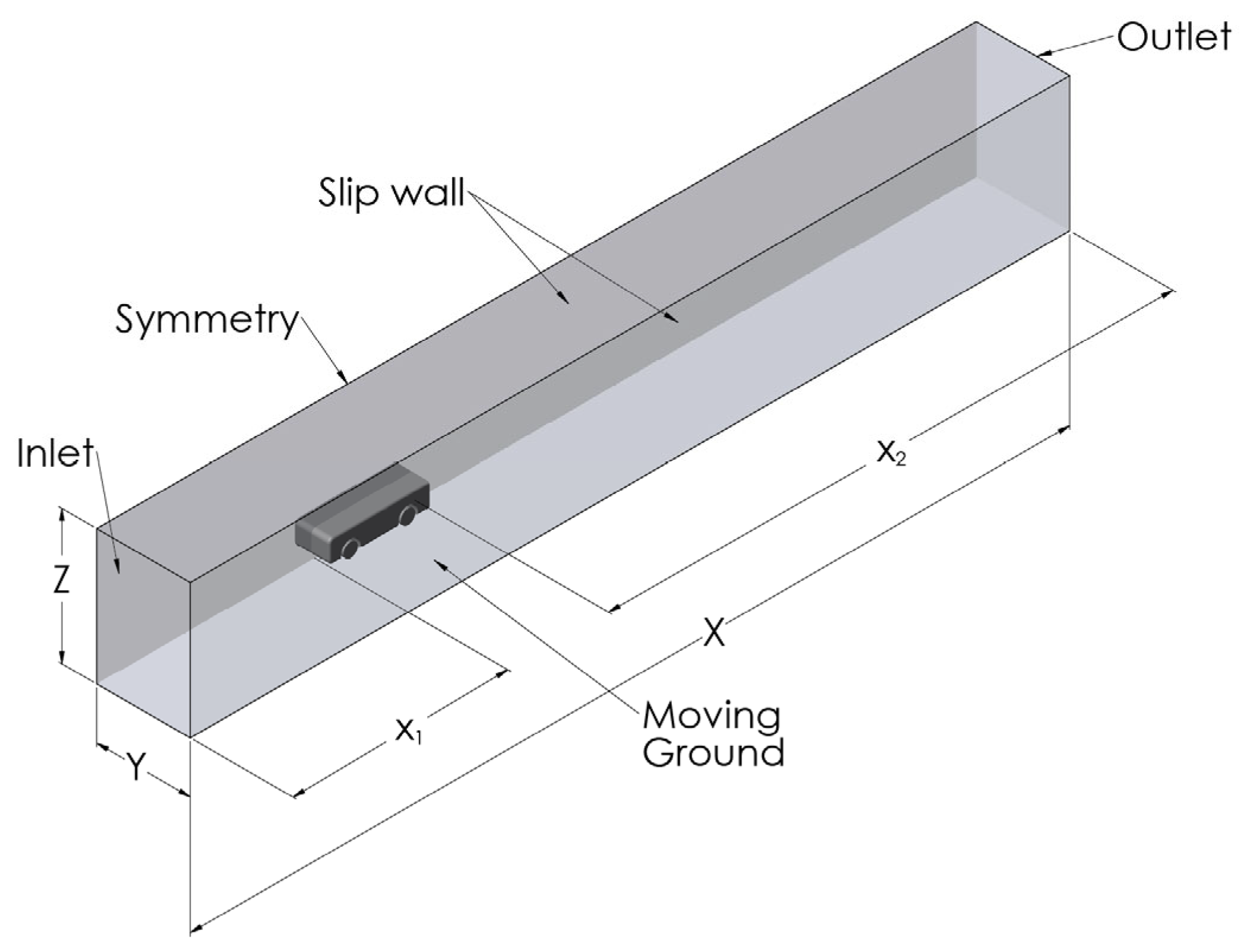

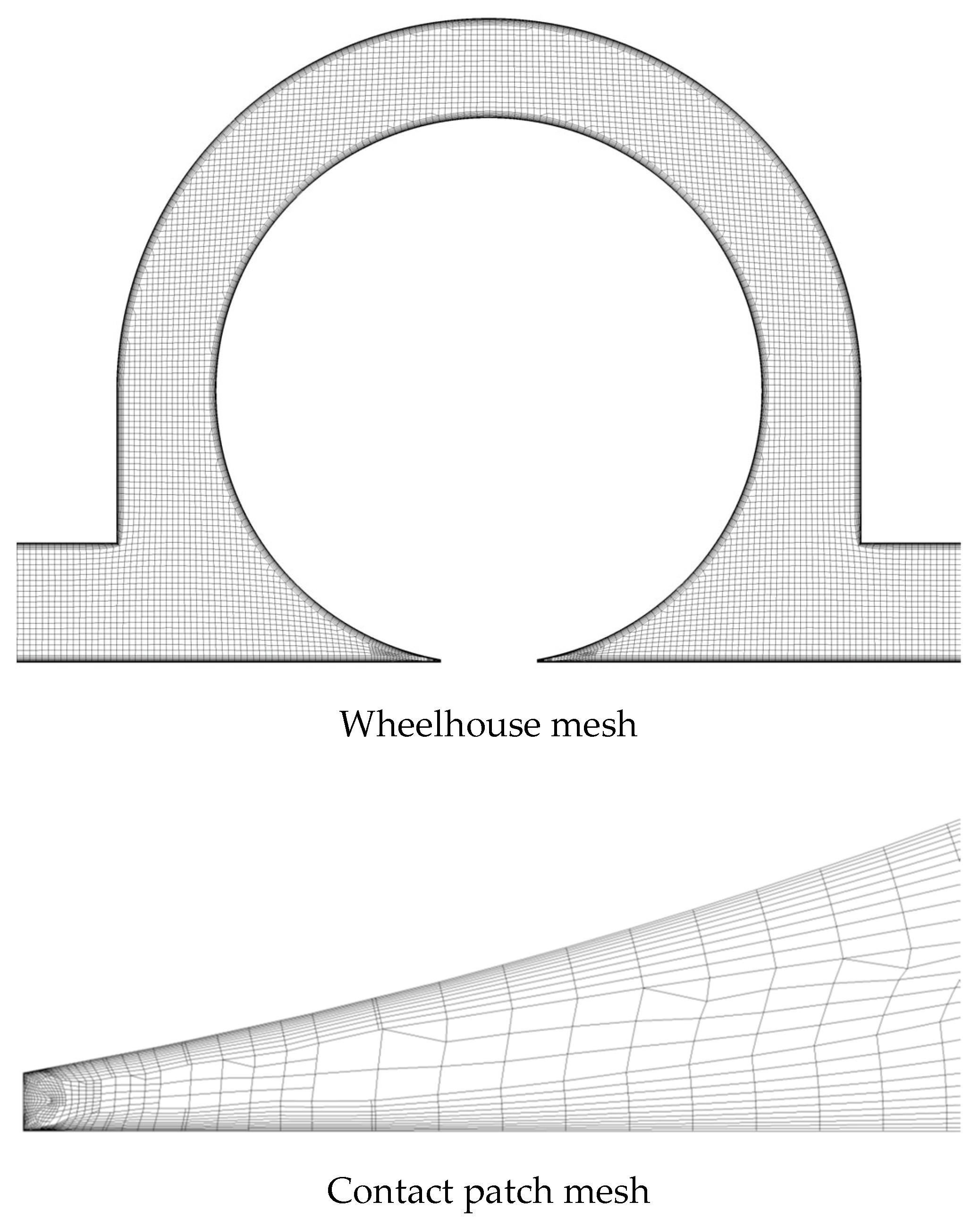
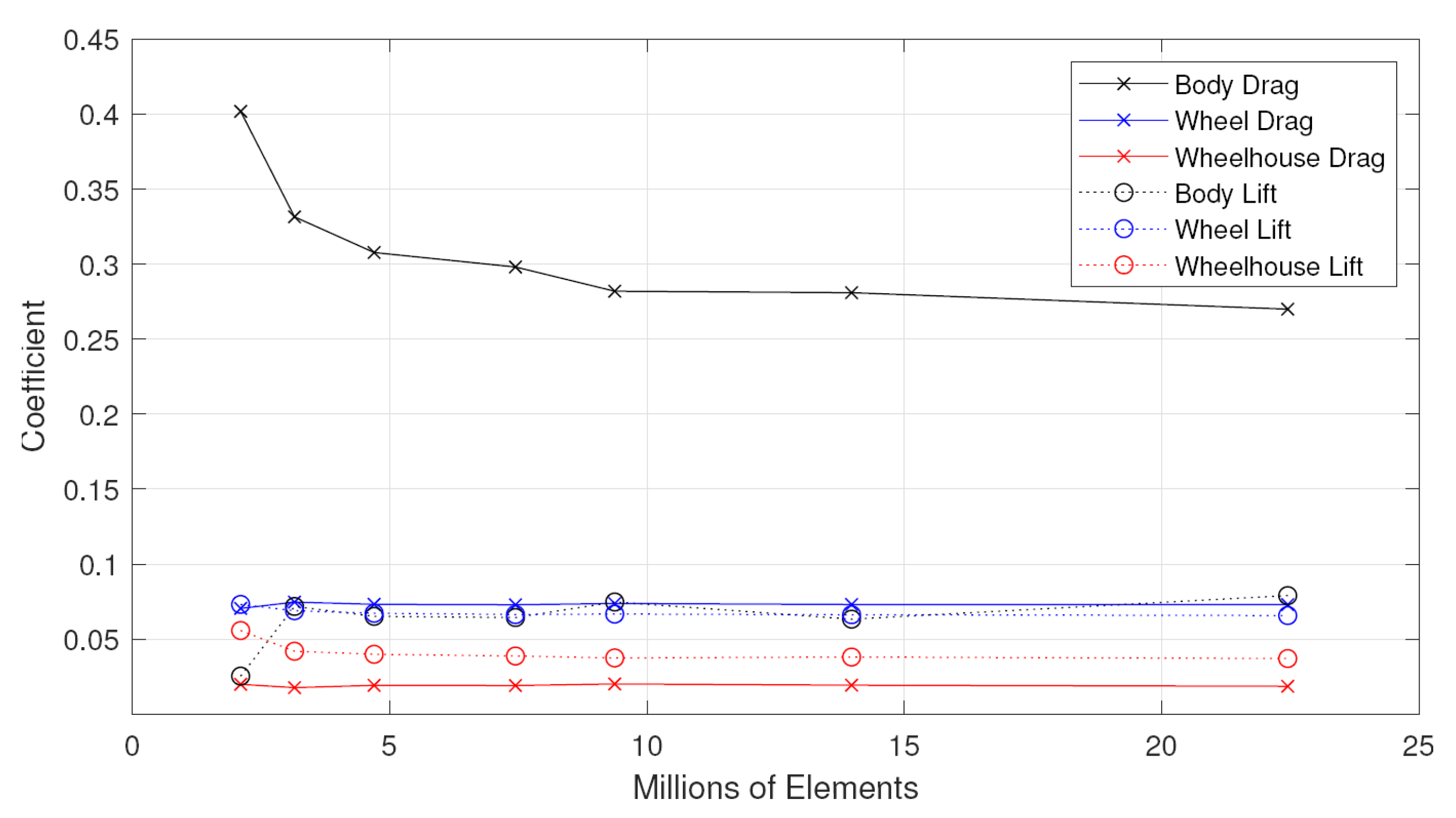
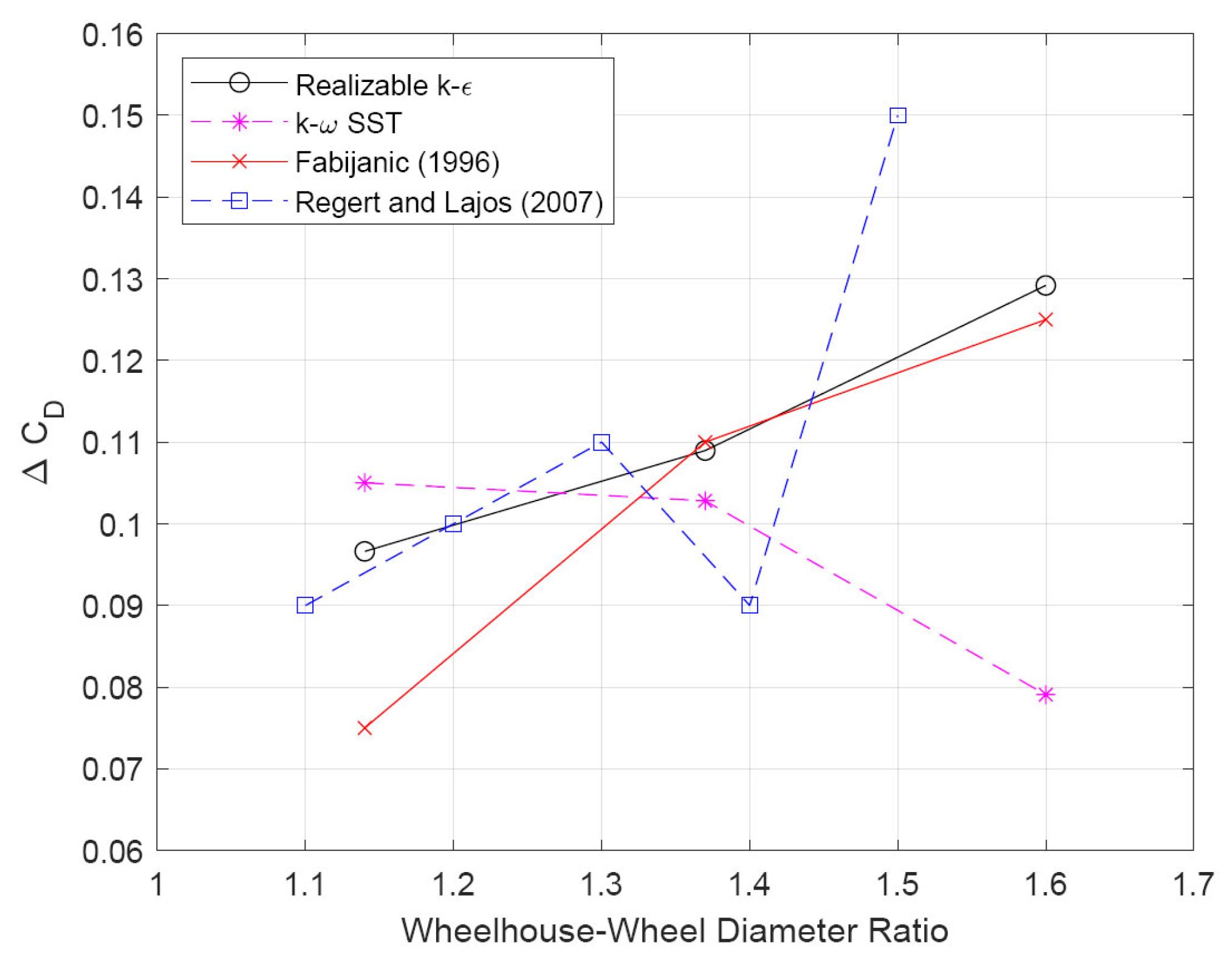
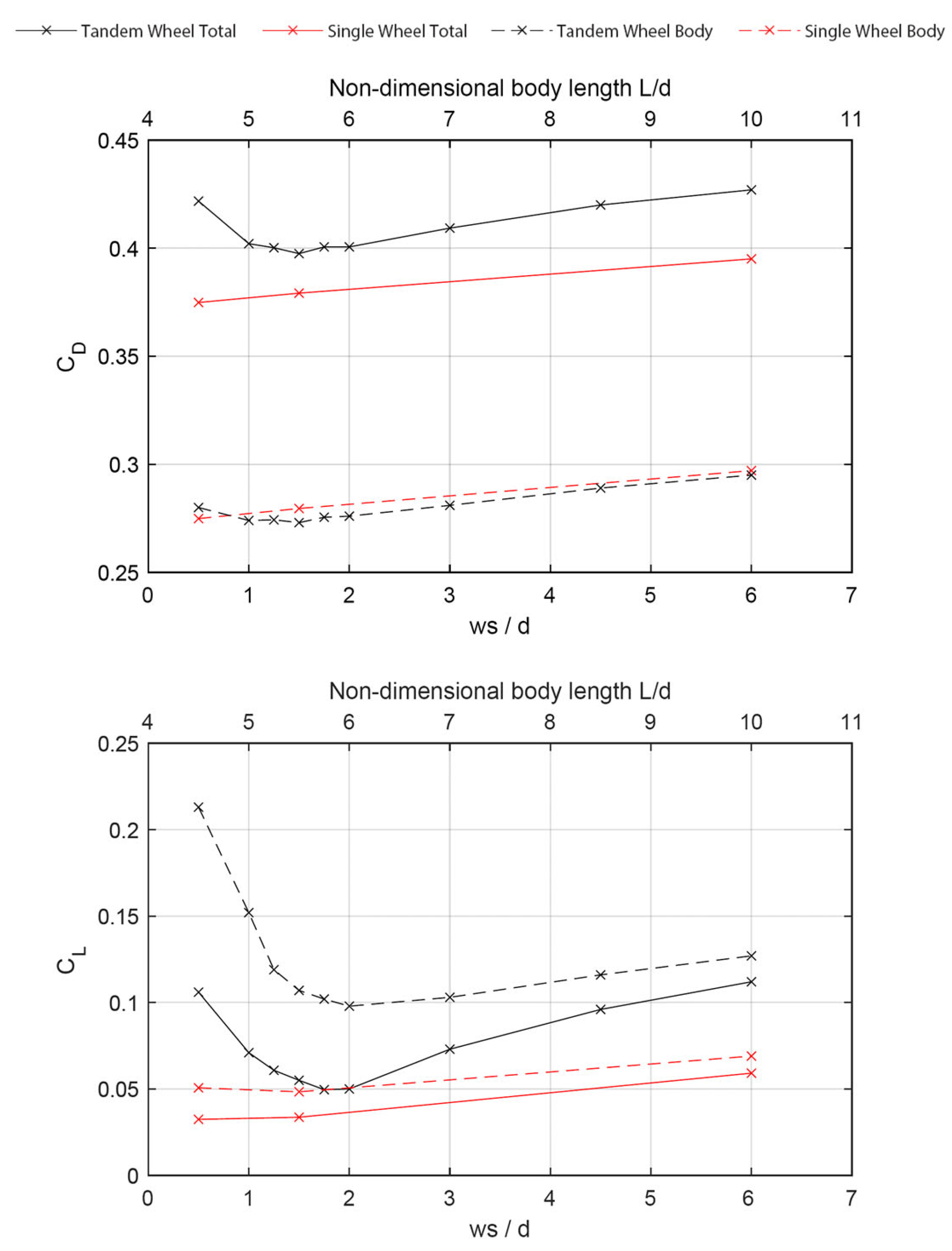

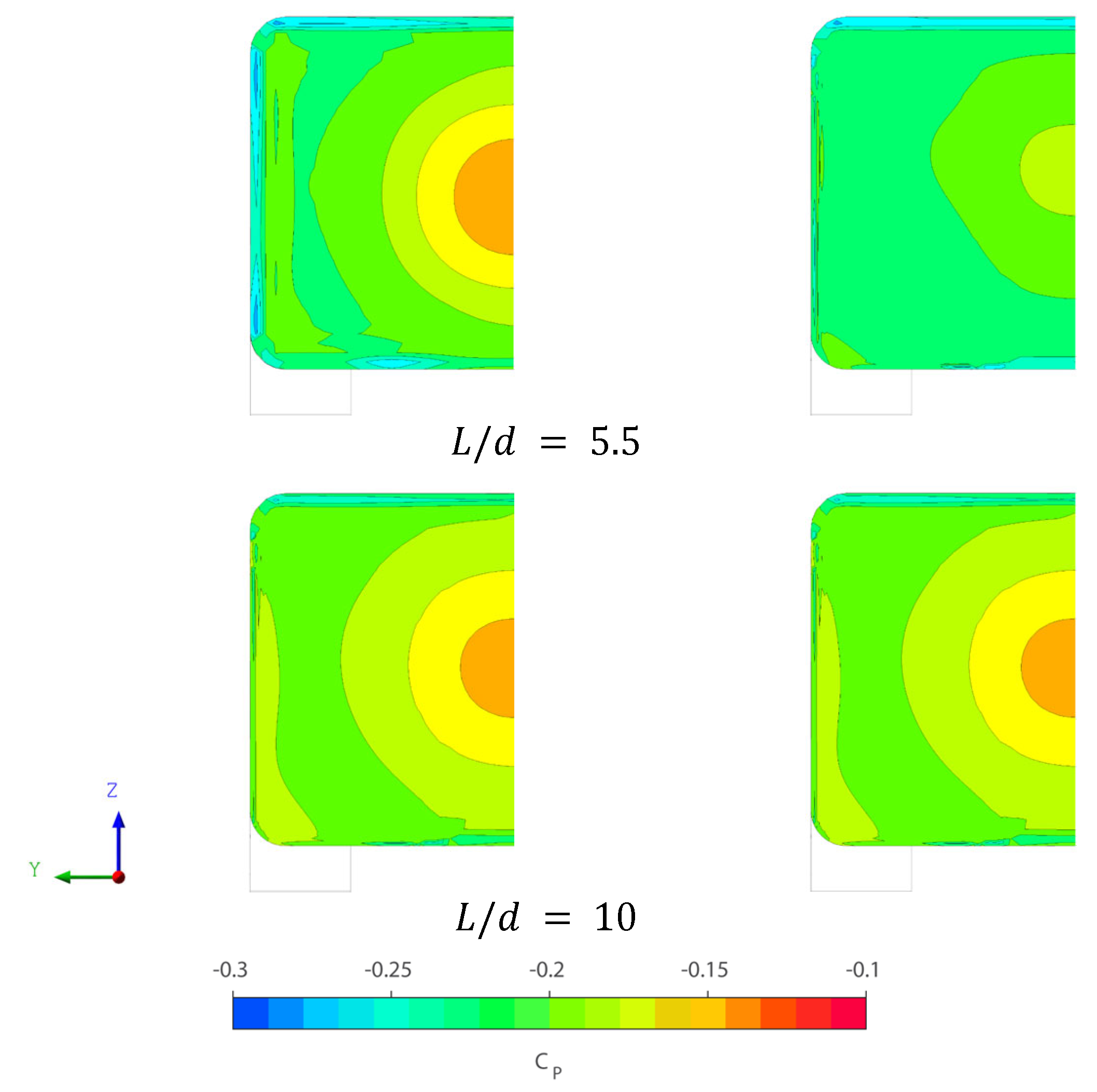
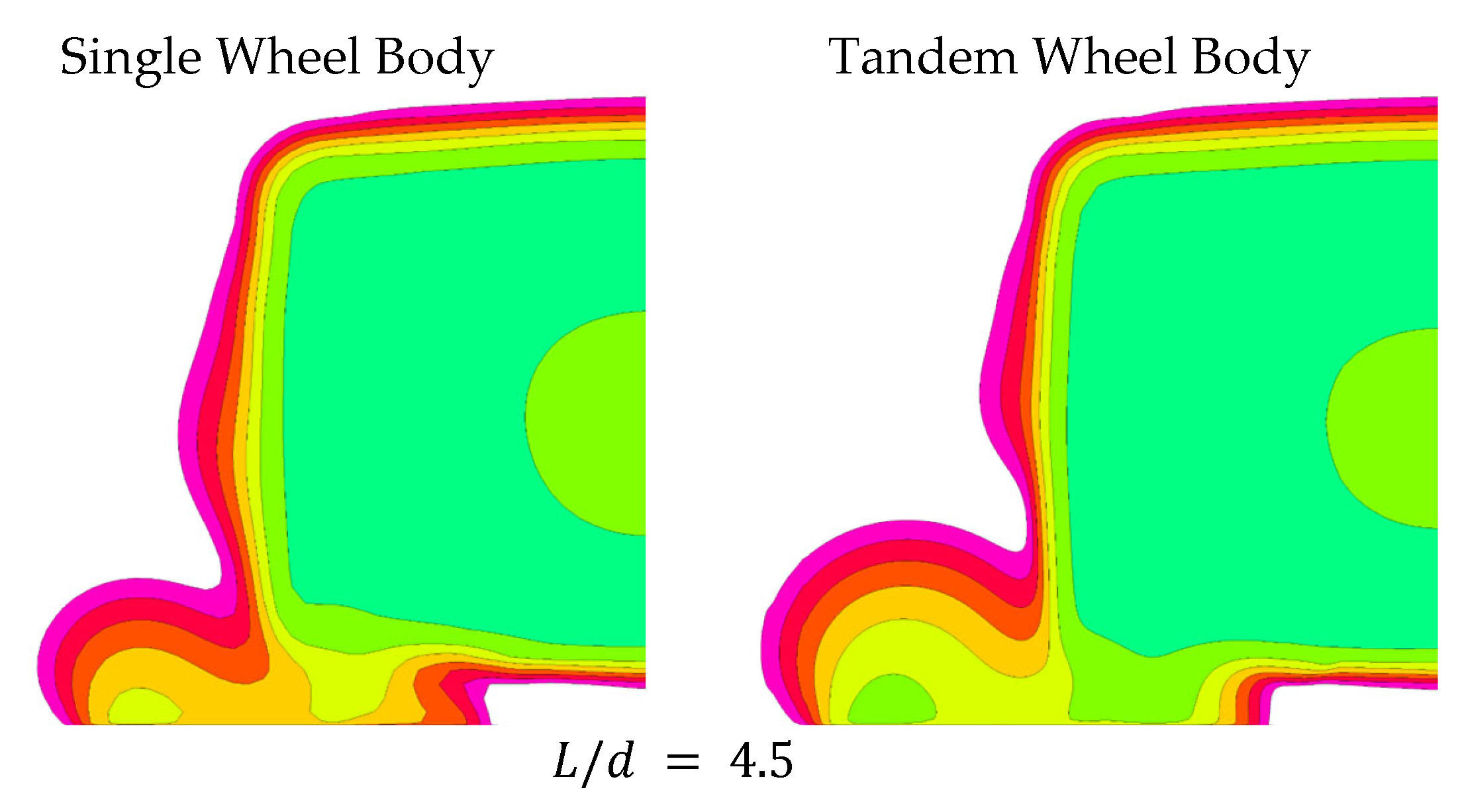


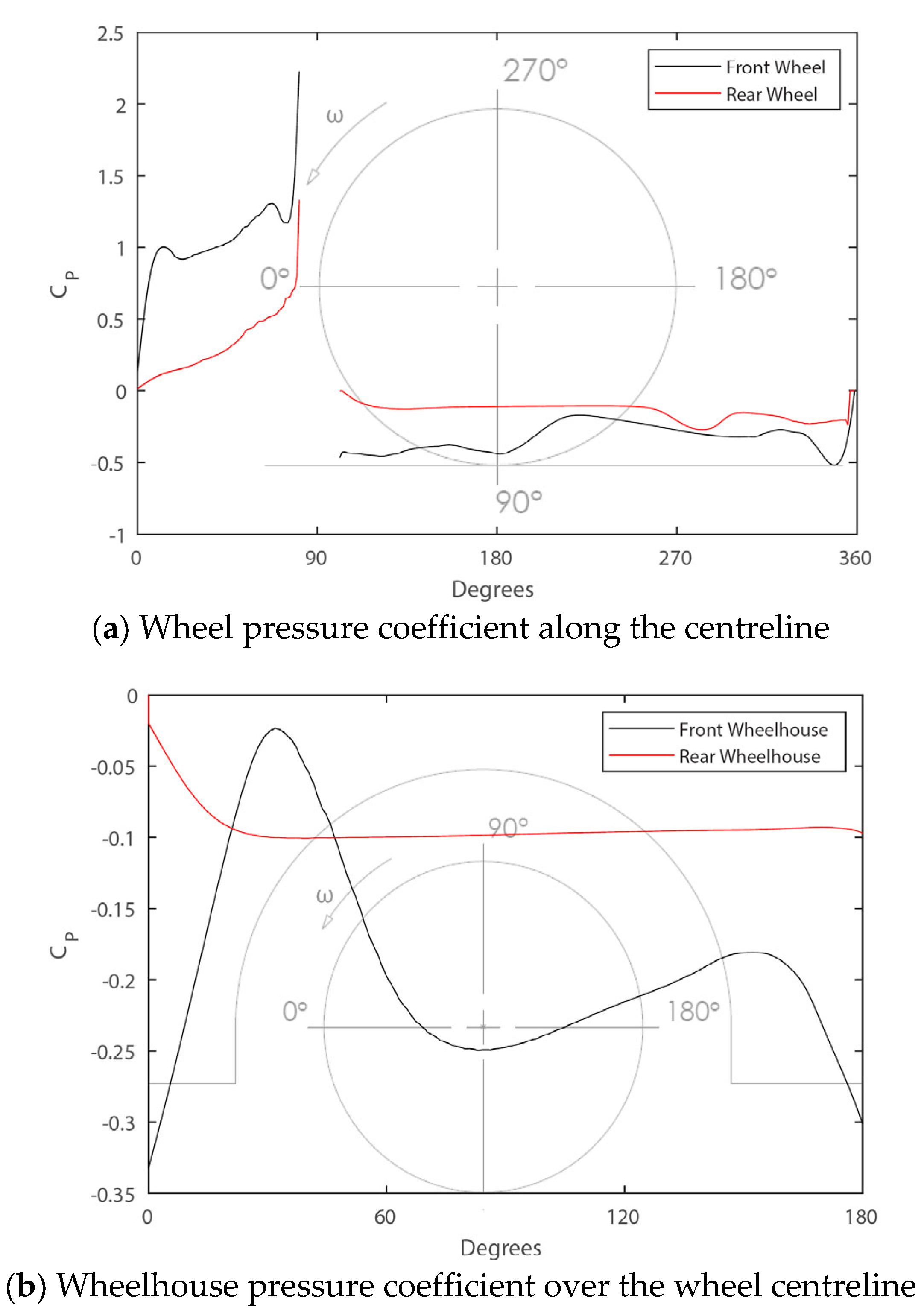
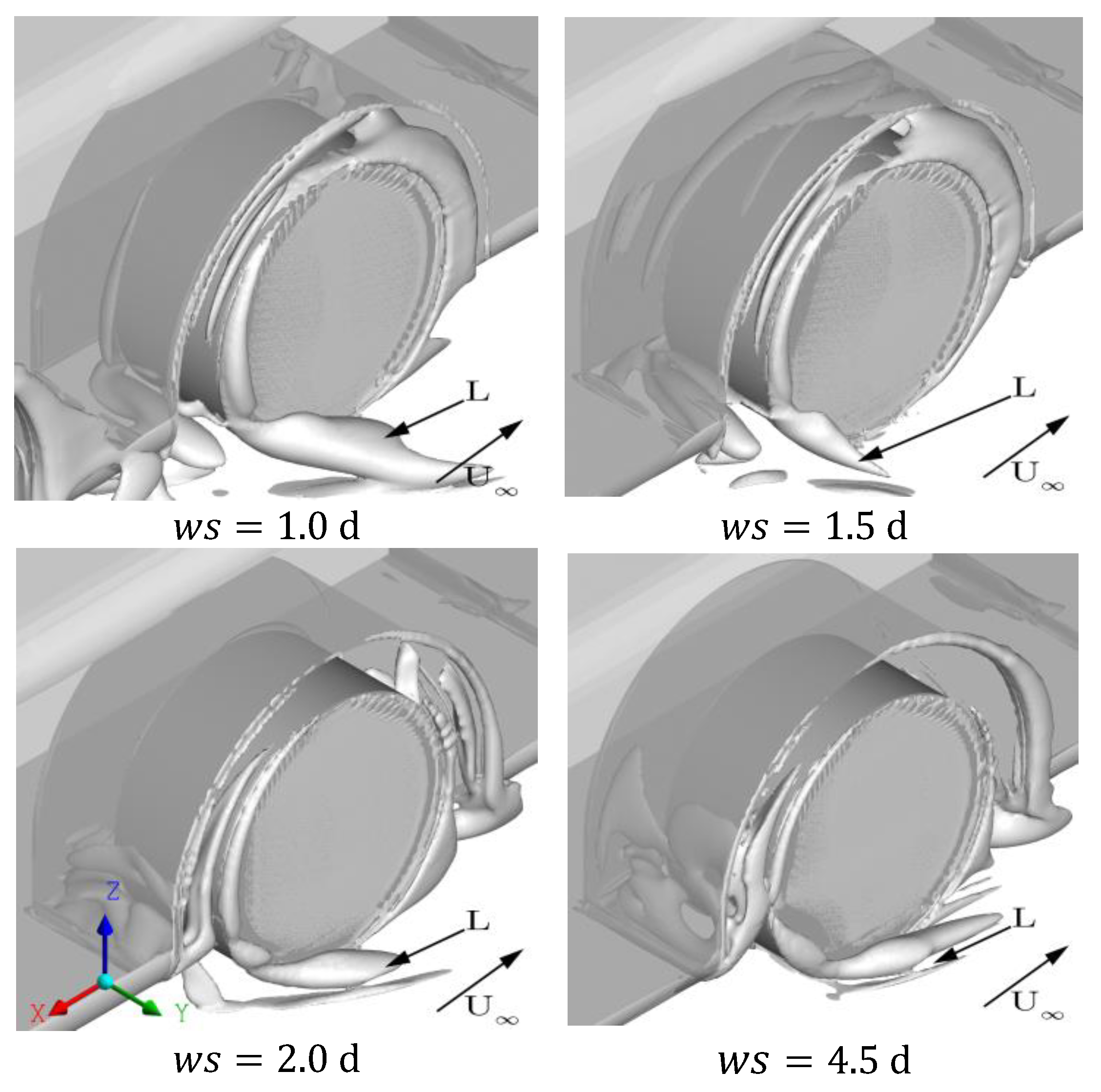


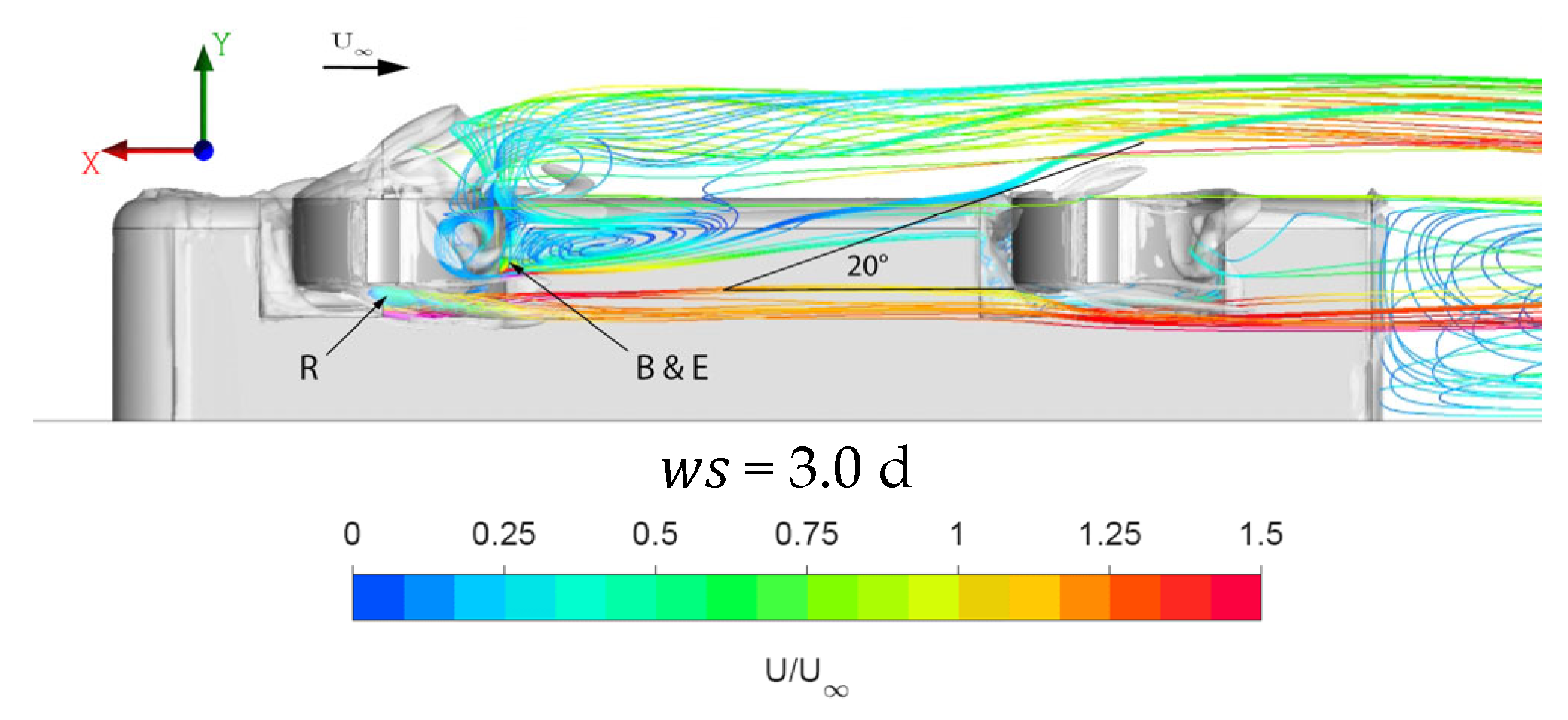

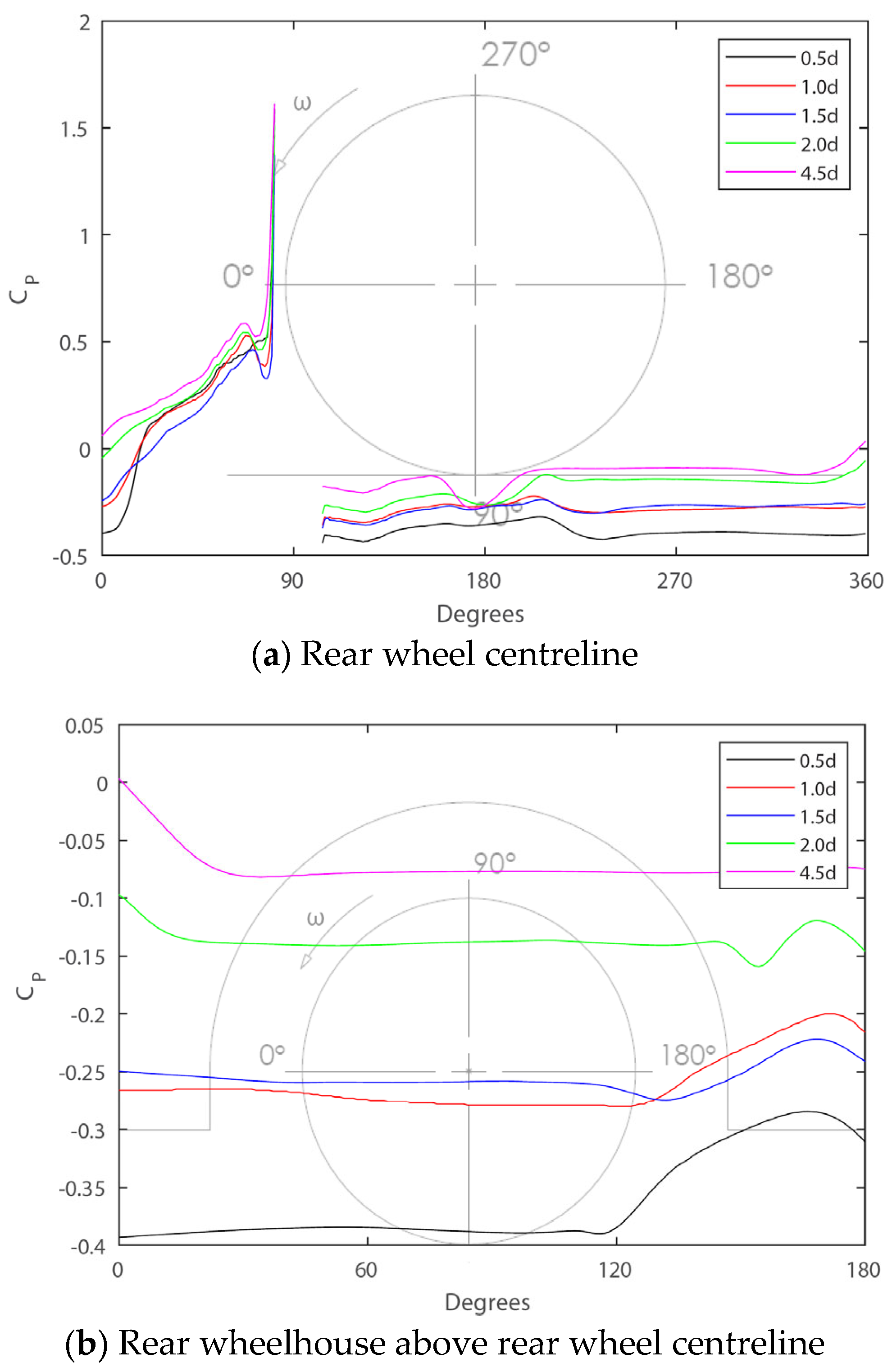
| H | 127 | ws | 229.8 | rwh | 52.3 | d = le = te | 76.6 |
| L | 536.2 | h | 16.8 | g | 14 | w | 36.2 |
| W | 190.5 | r1 | 25 | wwh | 50.5 | ||
| Dimensions in mm | |||||||
| 0.5 d | 1.0 d | 1.5 d | 2 d | 4.5 d | 6.0 d | |
|---|---|---|---|---|---|---|
| L | 344.7 | 383 | 421.3 | 536.2 | 651.1 | 766 |
| ws | 36.3 | 76.6 | 114.9 | 153.2 | 344.7 | 459.6 |
| Dimensions in mm | ||||||
Disclaimer/Publisher’s Note: The statements, opinions and data contained in all publications are solely those of the individual author(s) and contributor(s) and not of MDPI and/or the editor(s). MDPI and/or the editor(s) disclaim responsibility for any injury to people or property resulting from any ideas, methods, instructions or products referred to in the content. |
© 2023 by the authors. Licensee MDPI, Basel, Switzerland. This article is an open access article distributed under the terms and conditions of the Creative Commons Attribution (CC BY) license (https://creativecommons.org/licenses/by/4.0/).
Share and Cite
Radovic, R.; Salehi, F.; Diasinos, S. A Detailed Numerical Study on Aerodynamic Interactions of Tandem Wheels on a Generic Vehicle. Fluids 2023, 8, 281. https://doi.org/10.3390/fluids8100281
Radovic R, Salehi F, Diasinos S. A Detailed Numerical Study on Aerodynamic Interactions of Tandem Wheels on a Generic Vehicle. Fluids. 2023; 8(10):281. https://doi.org/10.3390/fluids8100281
Chicago/Turabian StyleRadovic, Radoje, Fatemeh Salehi, and Sammy Diasinos. 2023. "A Detailed Numerical Study on Aerodynamic Interactions of Tandem Wheels on a Generic Vehicle" Fluids 8, no. 10: 281. https://doi.org/10.3390/fluids8100281





